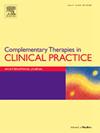芳香疗法对剖腹产产妇不适感的影响:随机对照试验的系统回顾和荟萃分析。
IF 2.2
3区 医学
Q2 INTEGRATIVE & COMPLEMENTARY MEDICINE
引用次数: 0
摘要
背景和目的:芳香疗法是一种涉及精油的非药物干预方法,已被建议作为围手术期不适的辅助疗法。本研究旨在系统研究芳香疗法在减轻剖腹产产妇疼痛及其他不适症状方面的疗效:方法:从开始到 2024 年 9 月,对 PubMed、Cochrane 图书馆和 Embase 进行了系统检索。纳入标准包括接受剖腹产手术的产妇、作为干预措施的芳香疗法以及疼痛、焦虑、恶心和呕吐等结果。分组分析探讨了不同对照组、精油、剂量、疗程次数和芳香疗法疗程长度的影响。统计分析采用 RevMan 5.3 进行,异质性采用 Q 检验和 I2 统计量进行评估:结果:共纳入 17 项研究,涉及 1490 名参与者。芳香疗法可明显减轻剖腹产后疼痛(SMD = -1.19, 95 % CI [-1.93, -0.45],p = 0.002)。洋甘菊精油、低剂量(≤2 滴)、单次治疗和持续 20 分钟或更短时间的治疗对缓解疼痛更有效。芳香疗法明显降低了恶心的发生率(RR = 0.52,95 % CI [0.33,0.81],p = 0.004),减少了镇痛药的需求量(RR = 0.60,95 % CI [0.49,0.73],p 结论:芳香疗法可有效降低术后恶心的发生率(RR = 0.52,95 % CI [0.33,0.81],p = 0.004):芳香疗法可有效减少剖腹产后疼痛、恶心和镇痛药的使用,并提高患者满意度。小剂量(≤2 滴)、单次、短时间(≤20 分钟)的洋甘菊精油似乎是缓解剖腹产后疼痛最有效的方法。本文章由计算机程序翻译,如有差异,请以英文原文为准。
Effects of aromatherapy on discomfort in mothers undergoing cesarean section: A systematic review and meta-analysis of randomized controlled trials
Background and Purpose
Aromatherapy, a non-pharmacological intervention involving essential oils, has been suggested as a complementary therapy for perioperative discomfort. This study seeks to systematically examine the efficacy of aromatherapy in alleviating pain and other discomforts in mothers undergoing cesarean sections.
Methods
A systematic search of PubMed, the Cochrane Library, and Embase was conducted from inception to September 2024. Inclusion criteria involved mothers undergoing cesarean section, aromatherapy as an intervention, and outcomes such as pain, anxiety, nausea and vomiting. Subgroup analyses explored the effects of distinct control groups, essential oil, dosage, number of sessions, and session length of aroma preparations. Statistical analysis was conducted using RevMan 5.3, with heterogeneity assessed using the Q test and I2 statistic.
Results
Seventeen studies involving 1490 participants were included. Aromatherapy significantly reduced post-cesarean pain (SMD = −1.19, 95 % CI [-1.93, −0.45], p = 0.002). Chamomile oil, low dosage (≤2 drops), single session and sessions lasting 20 min or less were more effective in relieving pain. Aromatherapy significantly decreased nausea incidence (RR = 0.52, 95 % CI [0.33, 0.81], p = 0.004), reduced analgesic requirements (RR = 0.60, 95 % CI [0.49, 0.73], p < 0.00001), and improved patient satisfaction (RR = 1.64, 95 % CI [1.26, 2.12], p = 0.0002).
Conclusion
Aromatherapy effectively reduces post-cesarean pain, nausea, analgesic use, and improves patient satisfaction. Chamomile oil, low doses (≤2 drops), single session and short length (≤20 min) seems to be the most effective method for alleviating post-cesarean pain.
求助全文
通过发布文献求助,成功后即可免费获取论文全文。
去求助
来源期刊

Complementary Therapies in Clinical Practice
INTEGRATIVE & COMPLEMENTARY MEDICINE-
CiteScore
6.30
自引率
6.70%
发文量
157
审稿时长
40 days
期刊介绍:
Complementary Therapies in Clinical Practice is an internationally refereed journal published to meet the broad ranging needs of the healthcare profession in the effective and professional integration of complementary therapies within clinical practice.
Complementary Therapies in Clinical Practice aims to provide rigorous peer reviewed papers addressing research, implementation of complementary therapies (CTs) in the clinical setting, legal and ethical concerns, evaluative accounts of therapy in practice, philosophical analysis of emergent social trends in CTs, excellence in clinical judgement, best practice, problem management, therapy information, policy development and management of change in order to promote safe and efficacious clinical practice.
Complementary Therapies in Clinical Practice welcomes and considers accounts of reflective practice.
 求助内容:
求助内容: 应助结果提醒方式:
应助结果提醒方式:


